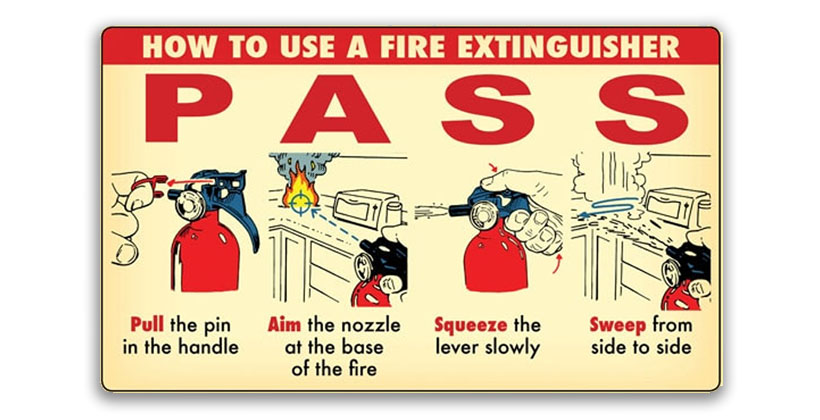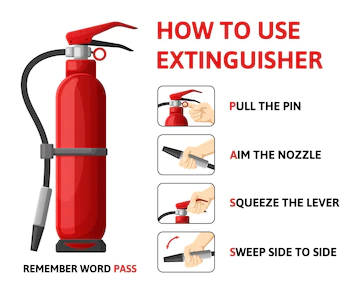
Anyone has quite a good chance of coming across an out-of-control fire at least once in a lifetime, therefore being able to use a fire extinguisher effectively is a crucial skill. The procedure for using a fire extinguisher in an emergency is described in this article. This method is recommended one from Ghana National Fire Service.
1. Call for help before attempting to extinguish a serious fire.
The fire may take hold much faster than you’re capable of dealing with it, and if help is on the way, it removes one less concern for you. The absence of panic could also help you think straight and deal with the fire appropriately, more effectively and efficiently. B. Call, or have someone else call, 192 as soon as possible. Ask National Fire Service to come immediately, giving your address (or Landmark) and a brief description of the type of fire. C.
Check that all other people are out of the house and also Check that they are all assembled at a safe meeting point. Do not allow children to attempt to use a fire extinguisher or control a fire in any respect whatsoever. D. Realize that reacting to fire requires a sound process of decision-making that children and some adults may not be capable of coping with their panic. Prior training on correct use can alleviate some of the concern here.
2. Check for your own safety before starting to extinguish a fire.
There are some key things to check for before you start fighting a fire using a fire extinguisher: B. Are you physically capable of extinguishing a fire? Some people have physical limitations that might diminish or eliminate their ability to properly use a fire extinguisher. People with disabilities, older adults, or children may find that an extinguisher is too heavy to handle or it may be too difficult for them to exert the necessary pressure to operate the extinguisher. C. Look for your exit points. Ensure that there is clear exit(s) for immediate escape should this become necessary.
At all times, keep your mind focused on the availability of a safe retreat. If this is threatened at all, leave at once. The Ghana National Fire Service recommends that you install fire extinguishers close to an exit point, to enable you to keep your back to the exit when you use the extinguisher; this ensures that you can make an easy escape if the fire cannot be controlled. D. Do not attempt to put out a fire where it is emitting toxic smoke; if you suspect or simply do not know if the smoke is toxic, leave it to the professionals. C. Check for structural safety of the building, in case burning walls, floors, or beams pose a risk to your safety. E. If you have more than one fire extinguisher, consider asking another mature and responsible person to use it in tandem with you. F. Remember that your life is more important than property, so do not place yourself or others at risk
3. Assess the fire.
Only a contained fire should be fought using a fire extinguisher. Portable fire extinguishers are valuable for immediate use on small fires because they contain a limited amount of extinguishing medium, which needs to be used properly or it will be wasted. For example, when a pan initially catches fire, it may be safe to turn off the burner, place a lid on the pan, and use an extinguisher. By the time the fire has spread, however, these actions will not be adequate, and only trained firefighters can safely extinguish such fires. B. Make a quick commonsense assessment about the utility and safety of using a fire extinguisher for the fire you’re experiencing. Obviously, a fire extinguisher is overkill for a candle but it’s useless when the whole house is on fire. A fire in a wastepaper basket, however, is another suitable candidate for fire extinguisher use. C. Use your instincts. If your instincts tell you the fire’s too dangerous to tackle, trust them
4. Ready the fire extinguisher.
Almost all fire extinguishers have a safety pin in the handle. This pin usually looks like a plastic or metal ring, sometimes colored red, which is held in place by a plastic seal. The distinctive features will vary depending on the type of fire extinguisher you have. You must break the seal and pull the safety pin from the handle before you can use the fire extinguisher by squeezing the lever, which discharges the fire extinguishing agent.

It helps if you ensure that you’re familiar with how your fire extinguisher works before being placed under pressure; take time to read over its instructions after you’ve read this article. Familiarize yourself with its special features and parts. Different extinguishers rely on different methods of use: be aware of this in advance of having to use them
5 Aim for the base of the fire.
Shooting into the flame is a waste of the fire extinguisher, as you’re not putting out the source of the flames. It’s vital to stop the fire at its source, or to remove or dampen the fuel from the fire, in order to put it out. By focusing the extinguisher’s spray at the base of the fire or the source, you are extinguishing the fire.
6. Remember the simple acronym P.A.S.S. to help you use the fire extinguisher effectively. P.A.S.S. stands for: Pull, Aim, Squeeze, Sweep.

Pull the safety pin from the handle. The pin is located at the top of the fire extinguisher. Once removed, it releases the locking mechanism, allowing you to discharge the extinguisher. o Aim the extinguisher nozzle or hose at the base of the fire. As explained, this removes the source or fuel of the fire. Keep yourself low. o Squeeze the handle or lever slowly to discharge the agent. Letting go of the handle will stop the discharge, so keep it held down. o Sweep side to side approximately 6in or 15cm over the fire until expended. The sweeping motion helps to extinguish the fire. Stand several feet or metres back from the fire: fire extinguishers are manufactured for use from a distance. o The fire may flare up somewhat as extinguishing begins due to the flames being pushed away from the burning material (the real target) by the agent and gust of propellant. Do not be alarmed so long as it dies back promptly.
7. Be aware that the typical fire extinguisher will contain around 10 seconds of extinguishing power.
If the extinguisher has already been discharged partially, this time will be less o If the fire does not respond well after you have used up the fire extinguisher, move to a place of safety quickly. If the room becomes filled with smoke, make a hasty exit.
8. Tend to the area if you have successfully put out the fire.
This means not leaving it alone, as it might re-ignite without warning. If it is safe to do so, remove fuel sources and commence cleaning up. Water can be used to ensure there are no remaining sparks in materials that are safe to extinguish with water (most combustibles other than oils and other insoluble combustible liquids or places involving electricity). The Fire Service could help you ensure the fire is completely extinguished.
9. Purchase a new fire extinguisher immediately.
The old one is now depleted and will serve no further purpose. Do not allow an empty extinguisher to be present where it could create the false impression of being a good extinguisher. A multi-purpose extinguisher is best for a home; check that it is labelled as such. Some fire extinguishers can be recharged; for smaller ones, replacing may be cheaper. o Fire extinguishers should be wall mounted in an accessible place. Keep out of the reach of children who are not responsible enough. o It is a good idea to always keep a fire extinguisher in the kitchen away from sources of heat such as the stove or cooking surfaces. o Other good places to keep a fire extinguisher include: your car, your garage (especially if you use welding equipment or flammable products), your caravan or RV. In each case, mount it somewhere accessible and protected from outdoor elements. o Ensure that everyone in the house knows where the fire extinguisher is located and how to use it (provided they are old enough and responsible enough to do so).